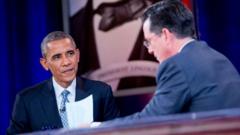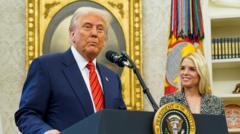Despite positive outcomes from recent discussions, the complex relationship between the U.S. and China continues to harbor significant challenges, including structural trade imbalances and geopolitical tensions.
**China and the U.S. Engage in Trade Talks: Progress Amidst Lingering Tensions**

**China and the U.S. Engage in Trade Talks: Progress Amidst Lingering Tensions**
Negotiations signal a shift in dynamics between China and the U.S. as tariffs are reduced, but major issues remain unresolved.
---
China's engagement in trade negotiations with the United States has marked a pivotal moment, albeit one layered in complexity. As Beijing seeks tariff relief amidst an ongoing economic struggle, recent discussions in Geneva have yielded some positive developments. US Treasury Secretary Scott Bessent has communicated that both sides agree on the necessity of maintaining a trading relationship, avoided the talk of decoupling that has recently permeated discussions.
While tariffs on Chinese imports will reduce from 50% to 30%, American tariffs on Chinese goods will fall to 10%. This unexpected concession has eased immediate economic concerns, particularly for investors watching closely for signs of stability in global supply chains.
President Trump heralded the talks as a "total reset," though this optimism contrasts sharply with the reality of underlying issues between the two nations. Beijing’s softened tone is informed largely by its current economic struggles, including high youth unemployment and uncertainty in consumer confidence as the country grapples with a property crisis.
The Chinese Commerce Ministry called the agreement a critical step toward resolving differences, emphasizing a desire for increased cooperation and underlining the necessity for the U.S. to correct its unilateral tariff decisions. However, the statement also served as a reminder of China’s resolve—asserting that patience has its limits, particularly in the face of perceived American aggression.
Despite the positive tone, the framework established in Geneva only offers a temporary pause on tariffs, set for 90 days, leaving the fundamental issues unaddressed. As both sides prepared for future talks, the trade balance—heavily favoring China—remains a daunting challenge, alongside major geopolitical frictions that continue to rise, especially concerning Taiwan.
Moving forward, the spotlight shifts to negotiations as both nations aim to find a more equitable path forward. Though the immediate tensions may have subsided, the road toward a truly balanced trade relationship is only beginning.
China's engagement in trade negotiations with the United States has marked a pivotal moment, albeit one layered in complexity. As Beijing seeks tariff relief amidst an ongoing economic struggle, recent discussions in Geneva have yielded some positive developments. US Treasury Secretary Scott Bessent has communicated that both sides agree on the necessity of maintaining a trading relationship, avoided the talk of decoupling that has recently permeated discussions.
While tariffs on Chinese imports will reduce from 50% to 30%, American tariffs on Chinese goods will fall to 10%. This unexpected concession has eased immediate economic concerns, particularly for investors watching closely for signs of stability in global supply chains.
President Trump heralded the talks as a "total reset," though this optimism contrasts sharply with the reality of underlying issues between the two nations. Beijing’s softened tone is informed largely by its current economic struggles, including high youth unemployment and uncertainty in consumer confidence as the country grapples with a property crisis.
The Chinese Commerce Ministry called the agreement a critical step toward resolving differences, emphasizing a desire for increased cooperation and underlining the necessity for the U.S. to correct its unilateral tariff decisions. However, the statement also served as a reminder of China’s resolve—asserting that patience has its limits, particularly in the face of perceived American aggression.
Despite the positive tone, the framework established in Geneva only offers a temporary pause on tariffs, set for 90 days, leaving the fundamental issues unaddressed. As both sides prepared for future talks, the trade balance—heavily favoring China—remains a daunting challenge, alongside major geopolitical frictions that continue to rise, especially concerning Taiwan.
Moving forward, the spotlight shifts to negotiations as both nations aim to find a more equitable path forward. Though the immediate tensions may have subsided, the road toward a truly balanced trade relationship is only beginning.






















